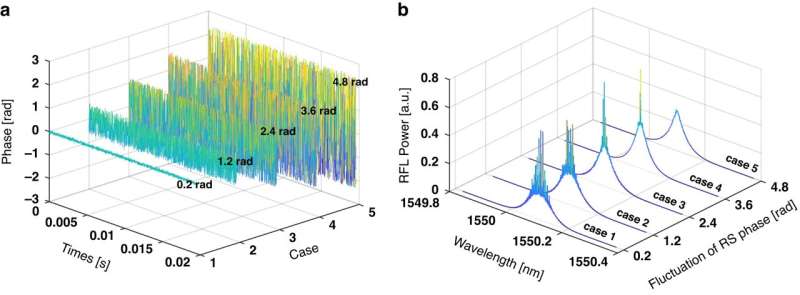This article has been reviewed according to Science X's editorial process and policies. Editors have highlighted the following attributes while ensuring the content's credibility:
fact-checked
peer-reviewed publication
proofread
Replica symmetry breaking in 1D Rayleigh scattering system: Theory and validations

In both the natural world and human society, there commonly exist complex systems, such as climate systems, ecological systems, and network systems. Due to the involvement of numerous interacting elements, complex systems can stay in multiple different states, and their overall behavior generally exhibits randomness and high disorder.
The complex interactions between factors such as solar radiation, terrain, and ocean currents, cause climate systems to exhibit various states, such as sunny, cloudy, and rainy. The dynamic changes and mutual influences of these factors make the behavior of the climate highly uncertain and difficult to predict accurately.
For instance, the formation and path of a storm can be influenced by multiple factors such as ocean temperature, wind speed, and atmospheric pressure, resulting in significant randomness and unpredictability.
Revealing the underlying patterns behind the behaviors of complex systems has been a focal point of research for scholars worldwide. Discovered in the early 1970s, magnetic spin glass systems became a paradigm of some complex systems and provide an important theoretical framework as well as experimental and numerical simulation platforms for describing and predicting the behavior of complex systems.
Giorgio Parisi, who introduced the concept of replica symmetry breaking in magnetic spin glass systems, discovered the interplay of disorder and fluctuations in physical systems ranging from atomic to planetary scales, revealing hidden symmetries in complex systems and earning him the 2021 Nobel Prize in Physics.
Against this backdrop, random lasers, due to their unique feedback and gain mechanisms, exhibit similar complex dynamics to spin glass systems with a large number of spins, thus becoming a key component in exploring spin glass theory.
Researchers have observed optical glassy phase transition phenomena in several random lasers. The current exploration of photonic phase transitions using random lasers has attracted widespread attention.
In a new paper published in Light: Science & Applications, a team of scientists, led by Prof. Zinan Wang from University of Electronic Science and Technology of China, Prof. Anderson S. L. Gomes and Prof. Ernesto P. Raposo from Universidade Federal de Pernambuco, and co-workers have investigated the underlying mechanisms of photonic phase transitions in one-dimensional Rayleigh scattering systems by establishing Rayleigh-scattering-phase-variation models.
They successfully established comprehensive connections between numerical studies and experimental phenomena, uncovering the unique laws governing photonic phase transitions in such systems.
The researchers offer a theoretical prediction of photon phase transitions. They propose that the output characteristics of such random fiber lasers depend strongly on the properties of Rayleigh scattering within the fiber.
Through precise analysis of the phase fluctuations of Rayleigh scattering in fibers using a phase-sensitive optical time-domain reflectometry (phi-OTDR) with proprietary technologies, a Rayleigh-scattering-phase-variation model is proposed for the phenomenon of replica symmetry breaking in random fiber lasers with Rayleigh scattering mechanism.
Theoretical predictions of the boundary parameters of photonic phase transitions in random fiber lasers are made, opening up new avenues for understanding the intrinsic mechanisms of photonic phase transitions.
The researchers also highlight the ubiquitous mechanism of photonic phase transitions. They discovered that the photonic phase variation in a random fiber laser with a Rayleigh scattering mechanism remains analogous to the role of temperature and disorder in the interactions between spins in the magnetic spin glass phase.
When the phase fluctuations of scattering elements remain stable, photonic phase transitions occur as the energy landscape of the system changes. However, fluctuations in the phase of scattering elements induced by external factors disrupt the interactions between different modes, thereby preventing photonic phase transitions.
This work takes a solid step toward revealing the universal phase transition mechanisms in different complex systems.
Based on the proposed model and high-precision spectral detection, this work theoretically predicted and experimentally observed a unique phase transition phenomenon in random fiber laser based on Rayleigh scattering—mode asymmetry.
This finding expands the current understanding of photonic phase transitions, providing a fresh perspective on the intrinsic mechanisms of complex systems.
Specifically, through exploration of the inherent connections between photonic phase transitions and the evolution of different modes in the random fiber laser, the work demonstrates that under the influence of unique feedback and gain mechanisms, different modes exhibit different states of nonlinear interactions.
Modes based on coherent Rayleigh feedback (manifested as randomly distributed peaks in the spectrum) experience strong nonlinear interactions leading to metastable states, thereby undergoing a photonic paramagnetic to spin glass phase transition; while modes based on incoherent Rayleigh feedback without nonlinear interactions remain in a paramagnetic state.
This work comprehensively explores the unique underlying principles of photonic phase transitions through theory, simulation, and experimentation, providing ample evidence that random fiber lasers based on Rayleigh scattering serve as an ideal platform for predicting, observing, and controlling photonic phase transitions.
Looking ahead, this achievement holds significant reference value for research in materials science, neural networks, quantum information, and other complex systems. Moreover, it is poised to advance the application of random fiber lasers in critical fields such as high-power laser devices.
More information: Yifei Qi et al, Replica symmetry breaking in 1D Rayleigh scattering system: theory and validations, Light: Science & Applications (2024). DOI: 10.1038/s41377-024-01475-5
Journal information: Light: Science & Applications
Provided by University of Electronic Science and Technology of China





















